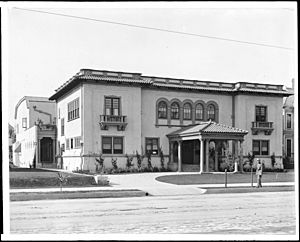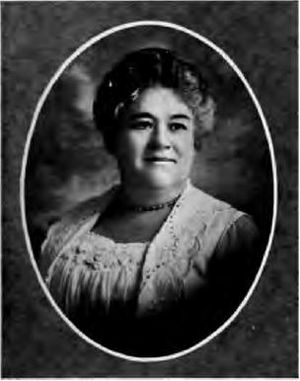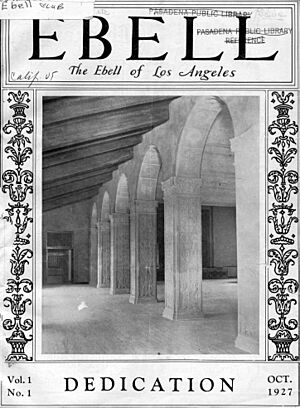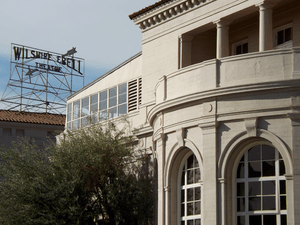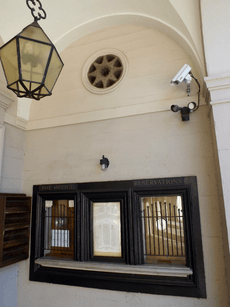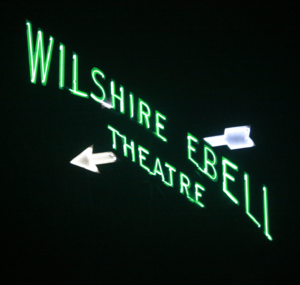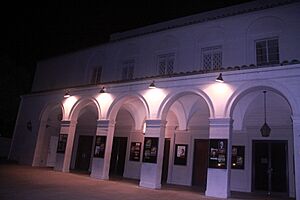Ebell of Los Angeles facts for kids
|
Ebell of Los Angeles
|
|

Ebell of Los Angeles, Wilshire frontage
|
|
| Location | 743 S. Lucerne Boulevard, Los Angeles, California |
|---|---|
| Built | 1927 |
| Architect | Hunt, Sumner P.; Schofield Engineering & Construction |
| Architectural style | Italian Renaissance |
| NRHP reference No. | 94000401 |
Quick facts for kids Significant dates |
|
| Added to NRHP | May 6, 1994 |
The Ebell of Los Angeles is a special place in Los Angeles, California. It's a historic building run by women, for women, and for the whole community. This amazing campus has many rooms for performances, meetings, and classes. It also has the large Wilshire Ebell Theatre, which seats 1,238 people.
The Ebell organization works to make Los Angeles a better place through art, education, and helping others. The women's group started in Los Angeles in 1894. They have owned and operated this beautiful campus since 1927.
Since it opened, the Wilshire Ebell Theatre has hosted many famous musicians and important speakers. For example, the famous pilot Amelia Earhart gave her last public speech here in 1937. This was just before her flight around the world, during which she disappeared. Also, the legendary singer and actress Judy Garland was discovered here in the 1930s when she was a young performer.
Contents
How the Ebell Club Started
The Ebell of Los Angeles began as a women's club in 1894. It was inspired by the ideas of Adrian John Ebell. He was a leader in women's education in the late 1800s. Harriet Williams Russell Strong was one of the club's founders. She served as its president for three years in a row.
The club's first meeting notes said its goal was "to interest women in the study of all branches of literature, art and science and the advancement of women in every branch of culture." Their motto became: "I will find a way or make one -- I serve."
Over the years, the Ebell group has offered many classes and lectures. These covered topics like psychology, travel, literature, music, and science. Even before moving to its current home, the club supported the arts. For example, in 1919, they sponsored a ten-week series of music concerts.
A New Home on Wilshire Boulevard
In 1923, the Ebell group decided to build a new clubhouse and theater. They chose a spot west of downtown on Wilshire Boulevard. The first piece of land they bought became more valuable, so they sold it for a good profit. Then, in 1925, they bought a new lot at Wilshire Boulevard and Lucerne.
The group hired architect Sumner P. Hunt to design the new buildings. He designed them in an Italian style. The buildings have plaster walls and Italian clay tile roofs. The new campus covers a large area, about 160 feet by 450 feet. It surrounds a beautiful patio area.
The new facilities included a 1,300-seat theater at the back of the property. The two-story building facing Wilshire Boulevard is the clubhouse. It has a big lounge, an art room, and a dining room. The dining room opens to a tiled walkway with a fountain.
The clubhouse opened in October 1927 with a musical tea party. The Wilshire Ebell Theater opened to the public in December 1927. It first showed the musical The Desert Song. The total cost for the land, buildings, and furniture was over $900,000.
When the buildings opened, the club's president wrote that the new home was "magnificent." She said it was "lavish, but not flamboyantly so." It was also "practical" and had "beauty and inspiring charm." The theater is known for its great sound and its special pipe organ. In 2003, the Los Angeles Times called the theater "a cultural centerpiece for Los Angeles."
The Four Sibyl Frescoes
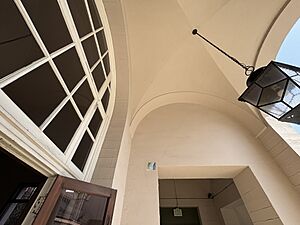
Artist Maxine Albro painted four large pictures called The Four Sibyls in the Ebell's central courtyard in the 1930s. A "Sibyl" was a prophetess in ancient times. One of the paintings, the "Portly Roman Sibyl," upset some club members. Because of this, the frescoes were painted over in 1935.
However, some art critics defended the paintings. One young critic, Arthur Millier, said, "Personally I think they are beautiful decorations which deserve to live and which will be missed." In early 2025, parts of these frescoes were uncovered during restoration work.
Famous Performances and Events
Over many years, the Wilshire Ebell Theater has hosted many famous stars and important events.
- Young Judy Garland, then known as Baby Frances Gumm, first performed on the Wilshire Ebell Theater stage. An MGM movie producer, George Sidney, saw her there. He later described her first audition. Another producer, Joseph L. Mankiewicz, also saw her perform at the Ebell. He was amazed by her talent. He met the 13-year-old Judy backstage and helped her get noticed by the studio.
- In 1937, Amelia Earhart gave her last public speech at the Ebell. This was before her ill-fated flight around the world.
- On February 2, 1938, Korean dancer Choi Seung-hee performed traditional dances on the Ebell stage. This was part of her tour across the United States.
- In 1964, famous pianist Glenn Gould gave his final public performance at the Ebell. He played pieces by Beethoven and Bach.
- In 1981, Filipino opposition leader Benigno Aquino Jr. gave a speech at the theater. He spoke about his life and struggles under martial law. The theater was packed with Filipino and American people.
Restoration and Historic Status
A big restoration project for the Ebell complex started in 1989. The theater's seats were redone, the stage was updated, and new sound and lighting systems were put in. Other parts of the building, like the main dining room and lounges, were also renovated.
In recent years, the Wilshire Ebell Theater has hosted many shows in different languages. These include Persian, Korean, and Russian. It has also been the site of annual "Divas Simply Singing" concerts. These events raise money for AIDS research and feature famous singers like Nancy Wilson and Roberta Flack.
The Ebell building is recognized as a historic place at local, state, and national levels:
- It was named a Los Angeles Cultural Historic Monument in 1982.
- It was added to the National Register of Historic Places in 1994.
- It has also been called an Official American Treasure by the National Trust for Historic Preservation.
Notable Members
Many important women have been members of the Ebell of Los Angeles, including:
- Lillie Stella Acer Ballagh
- Ida I. Bellows, who was president from 1910 to 1912
- Pearlretta DuPuy, a founding member
- Mabel Barnett Gates, the first vice-president
- Betty Gilmore
- Shirlee Taylor Haizlip, who was appointed president in 2000 and 2010
- Mabel D. Mullin
- Dora A. Stearns
See also
- Ebell Club of Santa Paula, California
- Ebell of Long Beach
- Ebell Society
- National Register of Historic Places listings in Los Angeles
- List of Los Angeles Historic-Cultural Monuments in the Wilshire and Westlake areas


